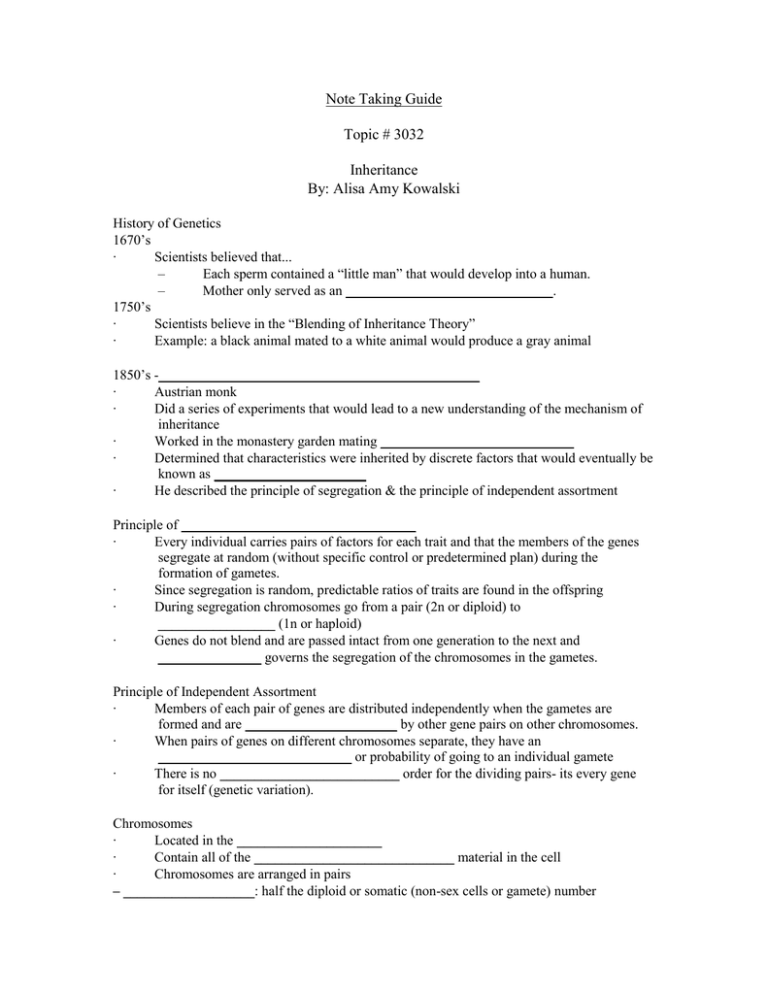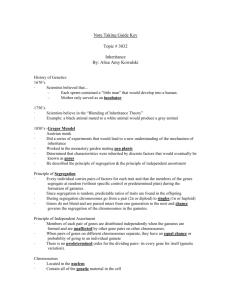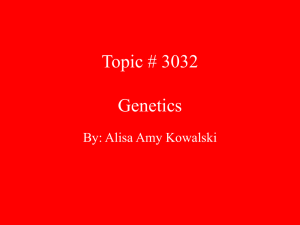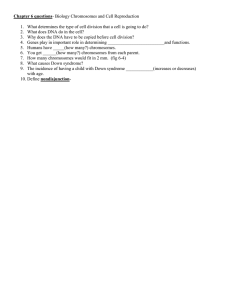Note Taking Guide Topic # 3032 Inheritance
advertisement

Note Taking Guide Topic # 3032 Inheritance By: Alisa Amy Kowalski History of Genetics 1670’s ∙ Scientists believed that... – Each sperm contained a “little man” that would develop into a human. – Mother only served as an ______________________________. 1750’s ∙ Scientists believe in the “Blending of Inheritance Theory” ∙ Example: a black animal mated to a white animal would produce a gray animal 1850’s -________________________ ______________________ ∙ Austrian monk ∙ Did a series of experiments that would lead to a new understanding of the mechanism of inheritance ∙ Worked in the monastery garden mating ____________________________ ∙ Determined that characteristics were inherited by discrete factors that would eventually be known as ______________________ ∙ He described the principle of segregation & the principle of independent assortment Principle of __________________________________ ∙ Every individual carries pairs of factors for each trait and that the members of the genes segregate at random (without specific control or predetermined plan) during the formation of gametes. ∙ Since segregation is random, predictable ratios of traits are found in the offspring ∙ During segregation chromosomes go from a pair (2n or diploid) to _________________ (1n or haploid) ∙ Genes do not blend and are passed intact from one generation to the next and _______________ governs the segregation of the chromosomes in the gametes. Principle of Independent Assortment ∙ Members of each pair of genes are distributed independently when the gametes are formed and are ______________________ by other gene pairs on other chromosomes. ∙ When pairs of genes on different chromosomes separate, they have an ____________________________ or probability of going to an individual gamete ∙ There is no __________________________ order for the dividing pairs- its every gene for itself (genetic variation). Chromosomes ∙ Located in the _____________________ ∙ Contain all of the _____________________________ material in the cell ∙ Chromosomes are arranged in pairs – ___________________: half the diploid or somatic (non-sex cells or gamete) number – of chromosomes (n or 1n) Diploid: number of chromosomes found in the somatic or body cells (__________). Also can be considered as twice the number of chromosomes found in the gametes (sperm or ovum). Chromosome Numbers Animal n 2n Cattle 30 60 Sheep 27 54 Goat 30 60 Swine 40 80 Horse 30 60 _____________________________________________ Chromosomes are made up of a substance called DNA DNA ∙ Deoxyribonucleic acid ∙ Made up of three components – Deoxyribose sugar – ___________________________________________________ – ________________________nitrogenous bases Nucleotides ∙ Combination of deoxyribose, phosphate and one of the four bases ∙ Band together to form _____________ strand of the DNA molecule ∙ Two of these strands wind around each other in a ______________________________ to form the DNA molecule The 4 Nucleotides ∙ ∙ The bases of the DNA hold the key to inheritance The four nitrogenous bases are – __________________________ (A) – __________________________Thymine (T) – __________________________(G) – __________________________Cytosine (C) ∙ In the two strands of DNA, – A is paired with ________ – __________ is paired with G Replication of DNA ∙ The double helix _________________ and pulls apart ∙ ∙ A new strand is formed using the old strand as a ________________________ The end result are two identical double helix strands The Gene ∙ Points of ___________________ found in each chromosome that govern the way in which traits develop. ∙ __________________ areas on each chromosome and are made up of DNA Genetic Codes & Protein Synthesis ∙ Each different possible code represents a ___________________ ∙ RNA (ribonucleic acid) is a group of molecules in charge of reading and translating the genetic code for the formation of new _________________________. ∙ RNA uses the DNA as a template to read the code in order to produce the right protein with the correct order and number of amino acids 3 Types of RNA ∙ _____________________ RNA (tRNA) – plays a key role in protein synthesis – each tRNA molecule can combine with one amino acid and can transport the amino acid to the new protein building site in the cytoplasm of the cell ∙ _____________________ RNA (rRNA) – plays a key role in protein synthesis – helps control the connecting of the parts of the protein (the amino acids) together. _____________________ RNA -mRNA ∙ Helps complete the building of the protein ∙ Physically sequences the amino acids that are carried to the building site by the tRNA & chemically connected by the rRNA ∙ Directs the sequence base on the order it obtains from the DNA molecules RNA Transcription ∙ __________ is paired with G ∙ T is paired with ___________ ∙ _____________ is paired with U Comparison to Building a House ∙ tRNA – people who haul the building materials to the construction site (cytoplasm - on the ribosomes) ∙ __________________ – People that drive the nails, pour the concrete, etc. ∙ mRNA – provides a physical pattern or blueprint for construction ∙ DNA – the original _____________________ that is kept in the main office (nucleus) that directed the plan






